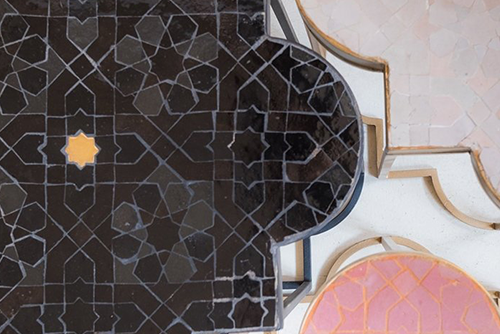Moroccan Chic
When it comes to interior design, Moroccan style is something with which most people are familiar. It has been fashionable for a long time among those who wish to adopt a more relaxed or bohemian approach to the design of their home and work spaces. The colours can be bright, combining many different textures and surfaces, furniture is generally very informal and typically low to the ground, and geometric patterns feature heavily. But why? Why is it that when we see these particular geometric designs we know immediately what part of the planet and which cultures they are from?
Over the ages various cultures have used figurative art to decorate their homes, from cavemen to the Victorian toile depicting people engaging in various activities such as picnics or dancing. In Islam, however, figurative depictions of prophets and Muhammad were condemned, which led to avoidance of this practice. Not wanting to shy away from the decorative arts, buildings have been covered from top to bottom with incredible designs of stunning intricacy and, at times, mathematical complexity. The three major pattern types that can be found in Islamic art are: calligraphy (the word of God), arabesque (vegetative art such as vines and flowers) and geometry, using only a ruler and a compass. Studies gifted to the world by Plato have ensured that there is plenty of information on the subject, securing its longevity. While the basis is essentially mathematical, this is one academic subject that offers so much more. The shapes and lines not only follow numerical codes but often mirror nature’s golden ratio too. Recurring themes are unity and repetition. Unity communicated with the use of a circle - a never ending shape telling us that we are all one, growing infinitely and the repetition of this shape making other shapes, a gentle but constant reminder of this unity.
Prevalent in the Middle East, Iran and Central Asia early versions of the designs have been traced back to the 8th and 9th Centuries often featuring simple star and lozenge formations. Later, the patterns became much more complex, incorporating elaborate radial symmetry of incredibly complex proportions.
According to Pythagoras, Plato and the ancient Greeks, there are five 3D shapes which are the core patterns behind physical creation. They linked four of them to the elements. Earth was associated with the cube, air with the octahedron, water with the icosahedron, and fire with the tetrahedron. Dodecahedron was considered to be the Universal Substance of creation, or the fifth element
Intricate and colourful patterns are, of course, beautiful in their own right but there is something that deepens the beauty when their meaning is revealed, especially when these patterns are carefully carved over vast areas on buildings, floors and artworks with extraordinary precision. Moroccan and Middle Eastern patterns have since been replicated in tiles, wallpapers, carpets, wooden furniture and details such as accessories and mirror frames many times over. Some are traditional and thoroughly authentic while some have more recently been reproduced in a much more modern style. This keeps an ancient style fresh and allows us the luxury of choice. Moroccan colours are traditionally rich such as burnt orange, kingfisher blue, teal, ochre, aubergine, fuchsia and, of course, gold but we can now choose the same patterns in neutrals, allowing much more artistic license in the rest of the room. The style can also tend to be dictated by the space itself - considering a small or particularly dark room cannot take intense colour/ pattern quite as easily, these new fresh options mean that a space can still have a Moroccan feel without it feeling too busy or over-designed. Scandinavian design fundamentals can also be applied to the style without deviating from an intrinsically Eastern feel - using muted colours but keeping the Moroccan patterns and textures creates an exotic and relaxed scheme but with the added freshness of modern Swedish-cool. The fundamental essence of this style is its appeal to the senses - each line carefully placed to meet another in an endless and ancient message reminding us that the universe is infinite. It is humbling and seeks to calm, constantly providing us with perspective and the knowledge that everything works better in harmony. Maths is not normally synonymous with the creative arts and yet here is proof that numbers have depth and style. Nature has always been the greatest designer of all and through geometry nature’s blueprint is revealed and it’s really rather exquisite.
No matter if you’re drawn to this design style because of it’s use of colour, shape, texture, or relaxed feel (or a combination of them all), our interior design team at FOC Design are here to help you explore all your Moroccan-inspired options and create the perfect design for your commercial or residential space.




